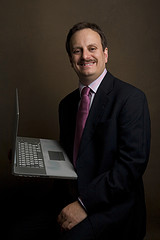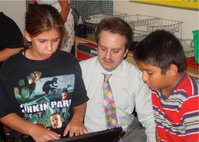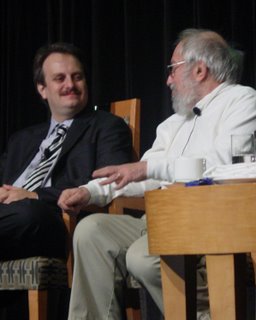Crocodile Tears
Wes Fryer's latest blog post, This is why we have so few laptop initiatives in Oklahoma, is a rallying cry for the technocenctric who think schools and universities should use any and all information technology available or our children will be left behind.
Wes is a nice guy, but I must confess that I am occasionally confused by his prolific blogging. He seems to justify any application, regardless of its quality or educational practice it supports, while simultaneously working tirelessly to scare the pants off parents and educators afraid of all the "bad stuff" out on the Web.
Fryer's blog states that Oklahoma Christian University and Abilene Christian University "are among the first colleges in the United States to implement initiatives which involve ALL students in entering classes purchasing and using either Apple iPhones or iPod Touches." Then he goes on to say...
I almost passed out on the spot, but I was torn by a simultaneous urge to weep.Question: What is Wes so upset about?
Answer: He met a professor at Oklahoma Christian University who "broke my heart"
It seems that the professor Wes spoke with was less than enthusiastic about the prospect of iPhone use in his classes. This in turn resulted in Fryer condemning the academic's disinterest in 21st Century skills (assuming they exist) and accusing the professor of all sorts of crimes against modernity.
Putting aside the generalizations drawn from a conversation with one academic, Wes' attempt to persuade the professor to embrace technology is as ridiculous as the institution's iPhone/iPod requirement.
Wes reaches into his bag of free Web 2.0 tricks and asks the professor if is aware of PollEverywhere. That's right. In Wes' world of plug kids into anything that plugs-in (as long as you remember that they may be abducted), PollEverywhere is just the ticket to "enthralled" [Wes' term] students.
On my planet, PollEverywhere sustains medieval educational practices. Thanks to Wes and PollEverywhere, a teacher can give a multiple choice quiz in class and get responses instantly via cell phone or other mobile device. That leaves me to answer, "WHO CARES?"
Justifying classroom technology use with such weak examples as PollEverywhere does not represent progress as much as it does desperation on the part of the evangelist. I am only worried about the professor if he is in fact persuaded by this argument.
Lots of institutions of higher education require students to have a personal mobile computer. Pepperdine University, where I work, required student laptops during the Clinton administration and I began working in K-12 1:1 schools before the first Gulf War. This however is not why Abilene Christian and Oklahoma Christian is being singled out by Wes Fryer. Wes is touting their requirement that each student have an iPhone or iPod Touch.
It is ridiculous to suggest that an iPhone or iPodTouch is an adequate learning tool.
These devices are great for looking up answers to easily answered questions or even blogging. However, they offer VERY little of the potential of computers as intellectual laboratories and vehicles for self-expression.
Why does an institution of higher education make such requirements? Because these devices 1) APPEAR cheap and 2) APPEAR modern and groovy.
So, the institution doesn't have the courage to ask kids to buy a multimedia laptop. Instead they suggest an iPhone and then shift the ongoing expenses to the student anyway in the form on monthly fees.
It might also be true that Abilene Christian and Oklahoma Christian have higher priorities than "21st Century Skills" or epistemological pluralism. To quote Hebrew National commercials, perhaps they "answer to a higher authority."
No matter what you think of the arguments above, I hope we can find common ground in stating unequivocally that neither the requirement that every college student own an iPod or the fact that professors don't embrace them has NOTHING whatsoever to do with Wes Fryer's blog title, "This is why we have so few laptop initiatives in Oklahoma."
Note: Here are a few recent examples of blog interactions to support the analysis above:
- Wes Fryer on Animoto vs Gary Stager on Animoto
- Gary Stager, Sylvia Martinez and others vs. Wes Fryer regarding interactive white boards
- Wes Fryer vs. Gary Stager on the "power" of Voicethread in education
Labels: animoto, Gary Stager, iwb, voicethread, web 2.0, Wesley Fryer






